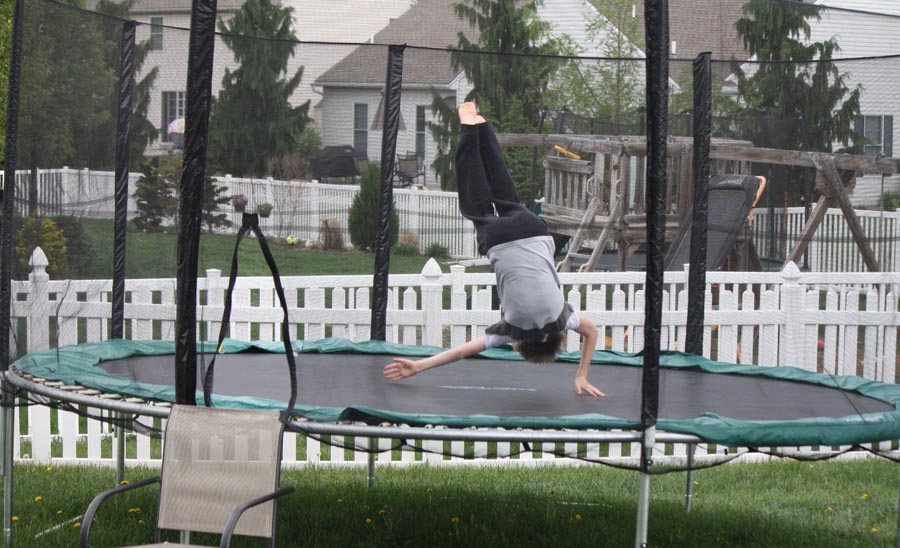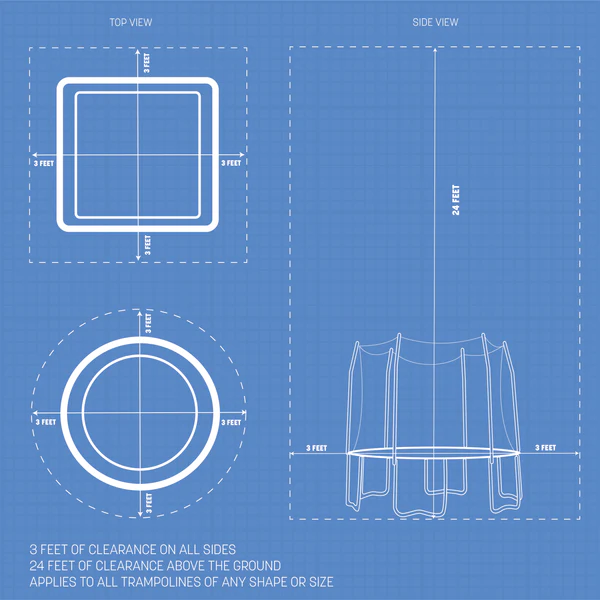
If you are considering adding a trampoline to your yard then there are many things you need to think about.
Size, shape and surface are three important S’s to consider, but equally important is where you position the trampoline.
And more precisely, how close can a trampoline be to a house, a wall, a fence or any other structure?
That is what we are going to look into today.
So without further ado let’s get started.
How Close Can A Trampoline Be To A House?
Trampolines with a safety net should have at least three feet (1m) of clearance from surrounding objects such as houses, walls and fences. Trampolines without a safety net should have at least six feet (2m) of clearance in the same circumstances. There should also be 24 feet of vertical clearance, measured from the ground up.
Trampoline Clearance Space: An Overview

If you are thinking about buying a trampoline it isn’t a case of saying, “oh my garden is 13 feet by 13 feet, I can buy any trampoline up to that size”.
Firstly it would be a real pain having your entire yard taken up by a trampoline!
Secondly, it wouldn’t be safe!
That is quite simply because, despite anyone’s best efforts, there is a likelihood that at some point someone will come off of the side of the trampoline.
And even if the trampoline has an enclosure net around it, if it is located right next to a brick wall, it could still result in a painful collision.
Therefore you always need to ensure you have a safety perimeter to keep your trampoline a sensible distance from any barrier like a fence, a house or a wall.
So how much clearance space do you need around a trampoline?
If your trampoline has a safety net, you will want at least three feet (1m) of horizontal space on all sides.
So if you are looking a buying a trampoline that is 13 feet by 13 feet, add six feet to the measurements to work out how much space you need in your yard.
So in this instance, if you have at least 19 feet by 19 feet of clear space in your yard you are good to go.
This image gives you a visible illustration of how much space you need.

If you have a trampoline without a net (which I don’t recommend) you want to double the safe space, so there is at least six feet (2m) of horizontal space on all sides.
You will also notice in the graphic above, you need to allow for a certain amount of vertical clearance to account for overhanging trees, power cables, roof edges, etc.
The recommended vertical clearance needed is 24 feet (7.3m), note that this is measured from the ground up.
So in summary:
- Horizontal space needed around a trampoline with a safety net: Three feet (1m) on all sides.
- Horizontal space needed around a trampoline without a safety net: Six feet (2m) on all sides.
- Vertical space needed (measured from the ground up): 24 feet (7.3m)
If you do have a smaller yard and are struggling for space for a trampoline, it is best to look for a square or rectangular models.
The shape and sizes of these models fit better with typical yard spaces, and they often offer the same jumping space as a circular trampoline, whilst taking up much less space.
Installing A Trampoline: What Else You Need to Consider

When it comes to buying a trampoline, the most important thing to consider is to make sure you have enough space in your yard.
If you don’t the story ends there.
If you do, then there are a few other things to think about.
Firstly, make sure the ground is flat. A trampoline should never be installed on a slope, as it will make it unstable and dangerous to use.
When it is set up make sure your children don’t leave anything under the mat.
They might think it is a great place to leave their toys, but you don’t want to end up with the scenario of having a couple of children playing with toys beneath the trampoline whilst a couple more are leaping around on the trampoline!
Also if the trampoline mat tears and anyone falls through, then these toys will pose a serious risk.
Before you go ahead and buy a trampoline check with all the relevant parties that it will not be a problem. This will include:
- Your landlord (if you are a tenant), to make sure they have no problems with you having a trampoline.
- Your HOA if you are part of one. They may have rules restricting what you can place in your yard, or where it can be placed.
- Your insurance company. Some insurance companies will refuse to cover a trampoline as part of a policy, or they might impose stringent restrictions and/or hefty premiums to do so.
Probably the most important person to check with is your neighbor, especially if the trampoline will be positioned anywhere where they could see it as an invasion of their privacy.
If children bouncing up and down on the trampoline can see into your neighbor’s property they might not be too happy about it.
Speak to them first and nip any potential problems in the bud before they arise.
Final Thoughts

When you are planning where to put a trampoline in terms of its proximity to your house (or a fence), there are some very basic guidelines to follow:
- With a safety enclosure: Allow three feet (1m) of horizontal clearance on all sides.
- Without a safety enclosure: Allow six feet (2m) of horizontal clearance on all sides.
- Allow 24 feet (7.3m), of vertical space measured from the ground upwards.
Keeping it a safe distance from houses, walls and fences eliminates the risk of anyone colliding with the said object and hurting themselves.
You will also need a nice flat spot, and to ensure you have checked with all external parties such as your insurance company, your HOA and your neighbors that you can put a trampoline in your yard.
Once that is done, you are good to go.
